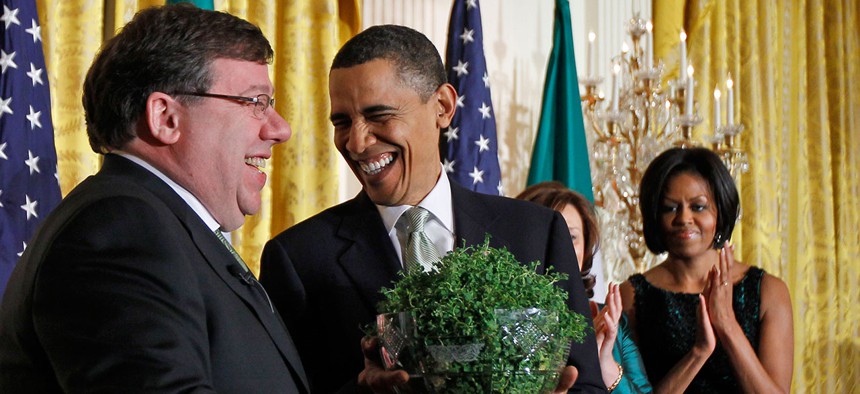
Obama receives a gift of shamrock from Ireland Prime Minister Brian Cowen in 2010. Alex Brandon/AP file photo
What Gifts Are Given to the U.S. President
For decades, foreign dignitaries have showered U.S. leaders with presents, ranging from the extravagant to the bizarre.
In 1880, Queen Victoria gave President Rutherford B. Hayes an ornate desk carved out of timber from the British ship H.M.S Resolute. Years later, that desk is now a fixture in the Oval Office, where generations of presidents have sat behind it. It’s perhaps the most visible symbol of the sometimes extravagant, and frequently bizarre, gifts presented to American presidents.
For decades, foreign leaders have showered them with presents: Theodore Roosevelt—a zebra and a lion from Ethiopia; Richard Nixon—a panda from China; George W. Bush—300 pounds of raw lamb from Argentina. Lloyd N. Hand, the chief of protocol during Lyndon B. Johnson’s administration, recalled an instance when the prime minister of the U.K. gifted the president a Burberry coat. As the delegation from the U.K. was leaving, Johnson tried on the coat and found that the sleeves were too short. Johnson gave the coat to Hand and asked him if he could catch the prime minister before he left and get the coat exchanged for the right size. Hand remembers dashing outside and running up to the limousine with the prime minister, while the Secret Service looked on, wondering what was happening. He managed to catch him and get the coat exchanged.
In the past, all gifts from foreign dignitaries had to be approved by Congress, after which they could become the property of the recipient. But as the U.S. gained prominence on the world stage, a division of protocol was created in 1928 to help presidents entertain visiting dignitaries and of course, organize the customary gift exchanges. Today, foreign gifts—from paintings to ceremonial daggers—are sent to the National Archives.
On one occasion, during George W. Bush’s administration, a call was placed to the National Archives to pick up a puppy. The president of Bulgaria had presented the puppy as a gift during an official visit and because U.S. presidents are limited in the gifts they can accept from foreign leaders, it had to be sent directly to the National Archives. But a puppy is difficult to archive, so it was eventually placed with a family.
President Obama and his family have received everything from swords to a “robe of sheer white fabric.” In some occasions, countries have presented a collection of small gifts, like when the government of Great Britain and Northern Ireland gifted Obama, among other things, a package of sea salt, a small, fabric-covered personal journal, and a set of four coasters. Brunei tried the same approach, giving the president among other gifts, 12 scented votive candles and a tea infuser in the shape of a penguin. That same year saw the Sultan of Malaysia give the president a 20-inch steel sword in a gemstone encrusted sheath, while not to be outdone, the prime minister of Algeria gave the president a ceremonial dagger with coral stones and silver work. Though nothing can probably beat the gift of crocodile insurance given by the chief minister of Australia's Northern Territory.
But just as presidents receive gifts, they’re also tasked with giving them, which can be equally challenging. For example, when Obama gave then-Prime Minister Gordon Brown of the United Kingdom a selection of classic American movies on DVD, the choice of gifts was derided in the British press as boring and unimaginative.
The president’s participation in gift selection varies depending on the individual in office. Hand recalls that Johnson would sometimes suggest what he wanted to gift. But on most occasions, the Office of Protocol brainstormed ideas and ran them past the president and the First Lady for approval.
When trying to put together a gift for a foreign leader that the president did not know well, Hand would call a meeting with the ambassador of the country to discuss gift options, along with the Secret Service and any other departments that were involved in the visit, he told me. Not surprisingly, one major restriction for official gifts is that they have to be made in America. For that reason, Tiffany silver and Steuben glass were always popular choices. President Bill Clinton had a custom-designed Tiffany silver cachepot that he gave to many visiting heads of state.
As the gifts that U.S. presidents received started to become more extravagant, a rule was enacted to ensure there was no impression of impropriety. The Foreign Gifts and Declarations Act of 1966 was prompted in part by the expensive gifts some Arab kings would bring on their visits, like luxury cars and fine horses, according to Hand. In political culture, “perception becomes reality,” says Hand, and it did not look good to have the president accept something that flashy from a foreign leader. The rule put a limit to the value of a gift a president could accept, with most gifts going directly to the National Archives after being presented. As of January 2014, the limit is currently set at $375.
The gifts of past presidents are located in the National Archives or are transferred to a Presidential Library when he retires. Presidents and other government officials have the option to purchase the gifts they received in office for their market value if they choose, as Hillary Clinton did following her tenure as secretary of state. She chose to purchase the black pearl necklace given to her by Myanmar opposition leader Aung San Suu Kyi in 2012, a gift, priced at $970. But usually, the gifts become a relic of past diplomacy, a little bit of history in the form of a novelty tea infuser or a ceremonial dagger, tucked away and carefully catalogued.






